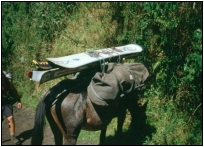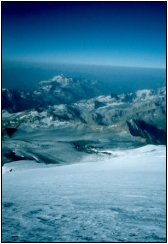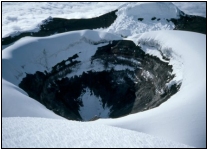|
|
The Sweet Neck Of The Moon by Dan Caruso - added August 31, 2006
Down on the equator in Ecuador lies one of the highest active volcanos on earth. At almost 20,000 feet above sea level, Cotopaxi rises high above the Amazon Basin in 'The Avenue of the Volcanoes.'
 For thousands of years, this massive smoking cone has been honored as a goddess to the indigenous peoples of the Andes. She speaks to them with the power of her gusting winds and smoking lava. She protects them from intruders and she motivates them to carry on their simple lives as hunters and gatherers. And when we traveled down there to climb this mammoth dome, she motivated us in much the same way.
For thousands of years, this massive smoking cone has been honored as a goddess to the indigenous peoples of the Andes. She speaks to them with the power of her gusting winds and smoking lava. She protects them from intruders and she motivates them to carry on their simple lives as hunters and gatherers. And when we traveled down there to climb this mammoth dome, she motivated us in much the same way.
Cotopaxi, roughly translated in a pre-Quechuan tongue, means ' The Sweet Neck of the Moon.' Her surface glimmers like a crater-filled planet in the night, and the eerie smoke rising from her summit cone leaves the impression that we, too, are walking up toward the moon.
 From the lowland 'Paramo' - the high desert country, we travel with donkeys up to the base of the hanging glaciers. At about 16,000 feet, we set up base camp and plan our assault on the volcano. She is alive, and it becomes obvious that we are not entirely welcome. Sheets of freezing hail turn our tent into an igloo, while gusting winds almost blow us away into the Amazon jungle, some 10,000 feet below.
From the lowland 'Paramo' - the high desert country, we travel with donkeys up to the base of the hanging glaciers. At about 16,000 feet, we set up base camp and plan our assault on the volcano. She is alive, and it becomes obvious that we are not entirely welcome. Sheets of freezing hail turn our tent into an igloo, while gusting winds almost blow us away into the Amazon jungle, some 10,000 feet below.
For a few days we are left to wait it out; no sense going up or down. We wait for a starry night to walk through the maze of glaciers that leads up to the summit cone. She teases us with glimpses of stars and moonlight; only to shut us down an hour later, forcing us back into the relative safety of our iced-over tent.
After a few more evenings, the winds die and the heavens appear. It may be a clearing or it may be a tease; either way, we make a run for it. This is our window and as supplies are dwindling, we must take advantage of it. From 16,000 feet, the air is thin, the night is bitter cold, and the going is slow. The moon glows high overhead and in a trance-like state, we walk to her. At almost 18,000 feet, we stumble under Yanasacha, the great black wall. Crevasses and hanging seracs gleam in the moonlight as falling ice echoes in the night. We walk through a giant ice machine and pray that Cotopaxi will show us mercy.
 At 19,000 feet, we begin our ascent of the steep headwall to the summit. The sun rises in the east and the skies shine in the cheery pink light. Slowly we trudge up the final slope as our frozen extremities begin to thaw. There is light at the end of the tunnel as we close in on the peak.
At 19,000 feet, we begin our ascent of the steep headwall to the summit. The sun rises in the east and the skies shine in the cheery pink light. Slowly we trudge up the final slope as our frozen extremities begin to thaw. There is light at the end of the tunnel as we close in on the peak.
A few hours later, we have breakfast with the Queen. Her throne-room reeks of the smoky sulfur escaping from the planet's core. Clouds form a vertical mile below. It is time to head back down to Earth.
As the sun rises in the sky, the icy snowpack softens and we begin our descent. Carving turns on frozen 'chickenheads' at 20,000 feet above sea level is not as easy as we had hoped. To get down in one piece will be accomplishment enough. Lower down through the glaciers, we find long, smooth slopes of corn-snow. Now we let the big dogs run.
By the time we get back to base camp, the howling winds have returned, along with the sleet and the clouds. Cotopaxi has allowed us to visit her realm, and the few hours on the moon are worth a lifetime on Earth.
We await the donkeys and head back into the Paramo. Again completely covered with clouds and nasty weather, Cotopaxi blows us a kiss farewell and seems like but a passing dream. We wonder if we were actually ever there. Perhaps such uncertainties are what life on the moon is all about.
|
|

